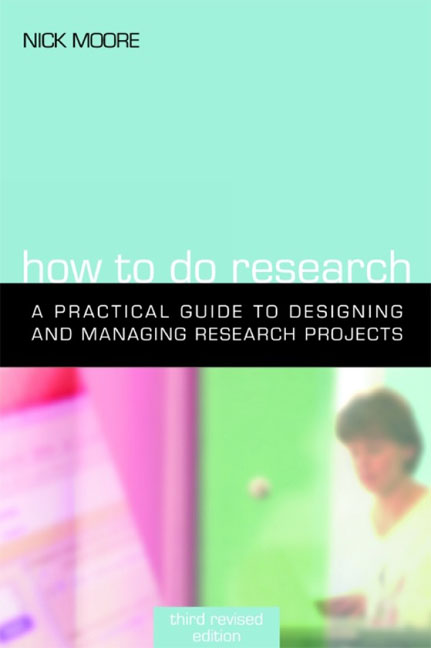Book contents
- Frontmatter
- Contents
- Acknowledgements
- Introduction: Types of research
- Part 1 The research process
- 1 Develop the research objectives
- 2 Design and plan the study
- 3 Write the proposal
- 4 Obtain financial support for the research
- 5 Manage the research
- 6 Draw conclusions and make recommendations
- 7 Write the report
- 8 Disseminate the results
- Part 2 Methods
- Appendix The market for information professionals: A proposal from the Policy Studies Institute
- Index
8 - Disseminate the results
from Part 1 - The research process
Published online by Cambridge University Press: 09 June 2018
- Frontmatter
- Contents
- Acknowledgements
- Introduction: Types of research
- Part 1 The research process
- 1 Develop the research objectives
- 2 Design and plan the study
- 3 Write the proposal
- 4 Obtain financial support for the research
- 5 Manage the research
- 6 Draw conclusions and make recommendations
- 7 Write the report
- 8 Disseminate the results
- Part 2 Methods
- Appendix The market for information professionals: A proposal from the Policy Studies Institute
- Index
Summary
To get the full value from your research you must be prepared to disseminate the results. You need to communicate information about the research and its results to those people and organizations that can make use of it. The art of good dissemination lies in your ability to select the dissemination channels that best suit the subject of the research and the nature of the audience.
Dissemination does not begin when the report is produced – you can start the process right from the outset of the project, alerting people to the existence of the research and preparing them for the eventual release of the results.
When thinking about dissemination it helps to think of three different audiences. The first have a stake in the research itself. They are actively awaiting the results and will want to see the full report. This group includes the research funders and all the people and organizations that are expected to take some action as a result of the work.
It is not difficult to disseminate to this group. They are receptive and, providing that they know that the report exists, you do not have to put much effort into selling it to them. Sad to say, for most projects, this first group is unfortunately never very large.
The second group consists of the people and organizations that will find something of value and interest in the report but who will not go out of their way to find a copy. You have to sell the report quite hard to this group. You must encourage them to consider the results and, if necessary, to act on the recommendations. Once their interest is aroused, members of this group will want the full report.
The third group may be interested in the subject of the research and might want to know a little about your work and what you found out. They will not really want to bother with the full report but could well be sufficiently interested to read a journal article based on it or to listen to a conference presentation. It is possible that, once they learn a little more about the research, they will follow it up and could well end up looking at the full report. But you will have to work quite hard to get them involved.
- Type
- Chapter
- Information
- How to Do ResearchA practical guide to designing and managing research projects, pp. 94 - 100Publisher: FacetPrint publication year: 2006

